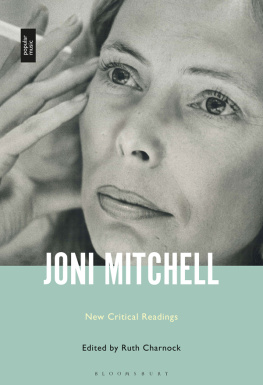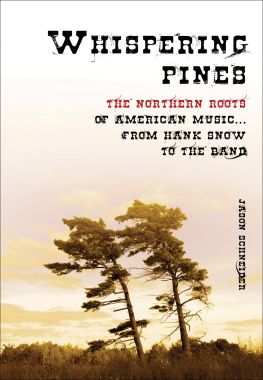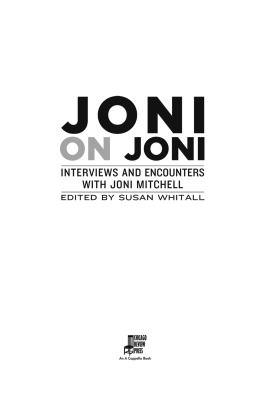The editor and publisher gratefully acknowledge the permission granted to reproduce the copyright material in this book:
Arc Iris, The Last Time I Saw Richard, performance at Great Scott, May 2017. Lyrics used by permission of the artists.
Of A Time. A. Beckett, 2018. Permission granted by the artist.
Every effort has been made to trace copyright holders and to obtain their permission for the use of copyright material. The publisher apologizes for any errors or omissions in the above list and would be grateful if notified of any corrections that should be incorporated in future reprints or editions of this book.
I go out, Im misunderstood, I see a butterfly, I go for a swim.
Joni Mitchell in conversation, 2013
Its weird. Everythings backwards, says Jocie Adams, in a 2017 gig recording, of Joni Mitchells The Last Time I Saw Richard (1971). And this cover is weird, if not immediately discernible as backwards. It starts with a series of looped samples of Mitchells speaking voice saying things like I see a butterfly, You cannot say I like this tomato soup without an ego. But I dont go around feeling misunderstood, I go for a swim, I go out, interspersed with a few sung responses from Jocie Adams, as if shes in conversation with Joni Mitchell or fantasizing about how she would reply to her, if she had the chance. Mundanely misunderstood, Adams chimes in at points in the songs opening; and Joni, chase that butterfly! at others. Just before the song moves into something a little more recognizable (but not wholly so), it breaks down into strange, discombobulating, minor key synth-burbles, as if the listener has gone for that swim with Joni and is now sitting on the bottom of the pool, watching the bubbles rise and hearing the glassy noises from above.
By using samples of Mitchells voiceall taken from a 2013 interviewto frame a song released in 1971, Arc Iris plays with time: creating a scenario where 2013 Joni talks to 2017 Jocie, who also brings 1971 Joni into the present (this time with synths and keyboards). Arc Iriss cover enacts a kind of temporal drag, to borrow Elizabeth Freemans phrase, a counter-genealogical practice of archiving cultures throwaway objectsobjects such as old interviews, lets say, or songs from the early 1970s (2010, xxiii). The important work of temporal drag, Freeman tells us, means revaluing and reevaluating retrogression, delay, and the pull of the past on the present (2010, 62), work, of course, that Joni Mitchell does in The Last Time I Saw Richard, by looking back to an encounter with an ex-partner while also, in complex analeptic and proleptic figures, dreaming of a time when this encounter will be over and the past wont have such a pull, work that Arc Iris does in their cover of the song, and work that this book also engages in. Time does not necessarily just move forward, as Mitchell has told us a number of times.
These samples and Adamss responses free Joni Mitchell up from the strictures of linear time, and, relatedly, from an interview with a man who kept interrupting her. Arc Iris interpretation reminds us of how boring it is to be misapprehended, whether you go around feeling it or not. I dont go around feeling misunderstood, Mitchell says, to which Adams replies, almost parenthetically, mundanely misunderstood. Mitchell, of course, has, at times, gone around feeling misunderstoodThe Last Time I Saw Richard is one such example. But, rather than pull her up on this, perhaps realizing how much of a drag it must be to have so many things youve thought or felt or said out there in the ether, for interpretation and misinterpretation, Arc Iris registers sympathetically what Joni doesnt sayor not here, at least.
These samples also evoke Mitchells mobility outside of the star-maker machinery: she goes out, she sees a butterfly, she goes for a swim. Sure, she has an egobut she doesnt let it weigh her down. And Adams wills Mitchell on to even more movementwhen Mitchell says, I see a butterfly, Adams interjects Joni, chase that butterfly!in a line that simultaneously harks back to and reaches forward out of Richards dark cocoon. In this, Arc Iriss cover imagines a Joni beyond the dreamer at the end of The Last Time I Saw Richard, waiting to get [her] gorgeous wings and fly away. Its a version of Joni Mitchell where she doesnt have to sit in boring interviews, or listen to boring ex-husbands, where she can swim, and look, and run, and be understood. Its a version where Arc Iris asks Mitchell to carry on seeking her joy, not to give up, to carry on after things that are fleeting, and not to let the pricks get her down.
As Lucy Robinson puts it, [s]inging someone elses songs, like re-using someone elses interviews is [...] a way of having a conversation with the past that keeps track of how it has been valued and maintained over time (McGeeney, Robinson, Thomson, and Thurschwell, 2018, n.p.). In the act of covering and sampling, Arc Iris also invites the listener to think about how they might, too, have valued and maintained an attachment to Joni Mitchell over time. Moreover, their performance invites us to reflect on how we make and make up Joni Mitchell, through scraps of things weve heard her say and pushed together, through other peoples words about her, through fantasized conversations with her, through glimpses of her in documentaries, and through the songsover 50 years of music, nineteen studio albums, two live albums, and nine compilations.
I open this book with what some might say is an esoteric objectin Arc Iriss coverbecause, in some ways, this is an esoteric collection, which looks for ways in to Mitchells music that feel weird and backwards, which samples from it here and there, which is interested in micro-moments, ephemera, as well as the more obvious objects, and in thinking about how listeners collaborate in making these objects. Covers are a way of brushing up against history while also making it present. They remind us that the song was an object that was made and can be remade and reexperienced but also that, every time we listen to a song, we participate in its making by making it our own. Every time we sing along in our rooms or in a karaoke booth, every time we listen to a song in our head (my friend calls it playing the psychic jukebox), as well as every time we play or sample someone elses song, we are cover artists. And every time we write about a song, too: the critic is also a cover artist, constantly citing, interpreting, reworking.
I also open with Arc Iriss cover because it is gorgeous and surprising and reminds us that Joni Mitchell, all the Joni Mitchells, are very much here: moving, pissed-off, dreaming, loving, thoughtful, disruptive, innovative, restless.
Long may that be so. Joni, chase that butterfly.
Notes
(accessed: June 2, 2018).
Joni Mitchell, The Last Time I Saw Richard, Blue (Hollywood: Reprise Records, 1971).
(accessed: June 2, 2018).
Works Cited
Arc Iris, The Last Time I Saw Richard, Great Scott, May 2017. https://www.youtube.com/watch?v=BcwDrseG_VA (accessed: June 2, 2018).
Balfour, Ian. Opening Remarks for Critical Karaoke Covers, Critical Karaoke 2014: Opening Remarks. http://popmusicstudies.org/ck/?p=7 (accessed: June 2, 2018).
Freeman, Elizabeth. Time Binds: Queer Temporalities, Queer Histories









